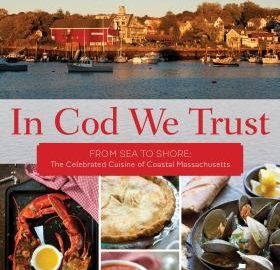
Bibliobites in June: The Home of the Bean and the Cod*
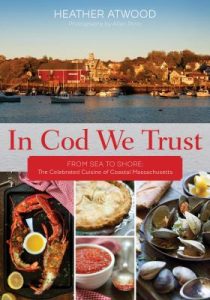 Ahh, home sweet home! This month our group stayed local with Heather Atwood’s In Cod We Trust: The Celebrated Cuisine of Coastal Massachusetts. This 2016 title takes us on a tour of our very own coast, from Provincetown to Newburyport, New Bedford to Nantucket. Though Yankee cooking, in its inimitable Rodney Dangerfield way, gets little respect for its sturdy plainness and extreme thriftiness, it’s these very qualities that likely account for its stubborn longevity. And, many of our local delicacies (like the aforementioned bean and cod) are infinitely adaptable to new ingredients brought by immigrants from all over the world. So perhaps our definition of Yankee fare needed some updating.
Ahh, home sweet home! This month our group stayed local with Heather Atwood’s In Cod We Trust: The Celebrated Cuisine of Coastal Massachusetts. This 2016 title takes us on a tour of our very own coast, from Provincetown to Newburyport, New Bedford to Nantucket. Though Yankee cooking, in its inimitable Rodney Dangerfield way, gets little respect for its sturdy plainness and extreme thriftiness, it’s these very qualities that likely account for its stubborn longevity. And, many of our local delicacies (like the aforementioned bean and cod) are infinitely adaptable to new ingredients brought by immigrants from all over the world. So perhaps our definition of Yankee fare needed some updating.
It turns out that the author of this book, Heather Atwood, is first and foremost a food historian and author. Chapter headings are loaded with information about a particular locale and its residents, and sidebars in most chapters showcase an area’s restaurants, farms, or noteworthy ingredients. Many recipes have longish headnotes about where the dish may have originated, and/or its variations. In a way this book is a tempting travelogue; if you lived somewhere else, the charming descriptions and evocative photos might have you booking a flight ASAP. Unfortunately, some of the places mentioned no longer exist, leaving us only wishing we’d been able to check them out.
 The book is arranged by region; for instance, there are chapters devoted to the south coast, or Cape Ann. At first blush this might seem sensible and even enjoyable, but for those of us actually cooking from this title, it quickly became an exercise in frustration and endless page flipping. If you wanted to find a particular fish dish (for example), you pretty much had to remember which section it came from. Why not consult the index? Good question, and the answer is that the index is the worst any of us had ever seen. Even if you had the exact name of a recipe, it often could not be found in the index. Especially in a title that’s not organized by main ingredient or by part of the meal, the index is vital. So perhaps we were a bit grumpy as we headed into the kitchen– did our efforts manage to soothe our souls? Or at least provide us with something delicious for dinner?
The book is arranged by region; for instance, there are chapters devoted to the south coast, or Cape Ann. At first blush this might seem sensible and even enjoyable, but for those of us actually cooking from this title, it quickly became an exercise in frustration and endless page flipping. If you wanted to find a particular fish dish (for example), you pretty much had to remember which section it came from. Why not consult the index? Good question, and the answer is that the index is the worst any of us had ever seen. Even if you had the exact name of a recipe, it often could not be found in the index. Especially in a title that’s not organized by main ingredient or by part of the meal, the index is vital. So perhaps we were a bit grumpy as we headed into the kitchen– did our efforts manage to soothe our souls? Or at least provide us with something delicious for dinner?
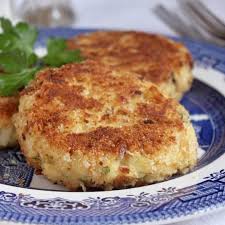 As expected, there were plenty of seafood recipes from which to choose. Two people tried Mondello’s fish cakes which were a “good, solid version” of this classic homey dish, containing the usual suspects of cod, potatoes, egg, and breadcrumbs. The recipe makes a good-sized batch, but they aged surprisingly well in the fridge, and can also be frozen. Fluke (or flounder) beautiful was “really delicious” and visually appealing with its tomatoes, olives, and parsley; a garlicky white wine sauce brought all together harmoniously. Two cooks took the time to put together cod a braz, a bit of a production involving fried potatoes, braised cod, eggs, and a cherry tomato relish. The relish was the best part of the dish by far, and would go with just about anything that could use a savory, acid foil. A keeper! Molho de tomate was another super tomato recipe that would be terrific with fish. This easy, long-simmered sauce had plenty of savory flavor from garlic and red wine; vinegar and pepper flakes added “a bit of a kick.”
As expected, there were plenty of seafood recipes from which to choose. Two people tried Mondello’s fish cakes which were a “good, solid version” of this classic homey dish, containing the usual suspects of cod, potatoes, egg, and breadcrumbs. The recipe makes a good-sized batch, but they aged surprisingly well in the fridge, and can also be frozen. Fluke (or flounder) beautiful was “really delicious” and visually appealing with its tomatoes, olives, and parsley; a garlicky white wine sauce brought all together harmoniously. Two cooks took the time to put together cod a braz, a bit of a production involving fried potatoes, braised cod, eggs, and a cherry tomato relish. The relish was the best part of the dish by far, and would go with just about anything that could use a savory, acid foil. A keeper! Molho de tomate was another super tomato recipe that would be terrific with fish. This easy, long-simmered sauce had plenty of savory flavor from garlic and red wine; vinegar and pepper flakes added “a bit of a kick.”  Fried cod squares with whipped potato, garlic, and olive oil dressing was yet another riff on the fish/potato combination. This iteration was a bit dressier than most, with an unctuously smooth potato and olive oil sauce dolloped atop the fried fish. The contrast of crunchy yet tender fish and the silky sauce was almost worth the effort, “I might make again!”
Fried cod squares with whipped potato, garlic, and olive oil dressing was yet another riff on the fish/potato combination. This iteration was a bit dressier than most, with an unctuously smooth potato and olive oil sauce dolloped atop the fried fish. The contrast of crunchy yet tender fish and the silky sauce was almost worth the effort, “I might make again!”
In the shellfish department, Rockport lobster roll was “your basic lobster roll,” which isn’t a bad thing. This particular recipe includes minced celery, which apparently is against the laws of nature in some lobster-loving locales. You are forewarned! Scalloped scallops had a “delicious flavor” with plenty of butter and a nice hit of salt from the crackers. The called-for saltines did get soggy; a few in the group mentioned that Ritz crackers are a better choice in such situations. Mussels mariniere featured a twist on this traditionally brothy dish: a creamy, buttery roux-based sauce. Our cook found this “easy, but too rich….[and] a mess to eat.” 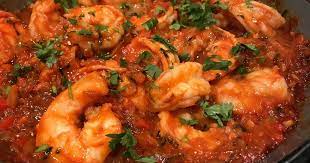 Portuguese spicy shrimp showcased an ingredient that we weren’t familiar with: pimenta moida, a spicy sauce made of red peppers fermented with salt. It’s not something that’s commonly found in supermarkets, so our cook made do with chili sauce. Garlic, smoked paprika, and white wine added complexity for a quick, easy, and zippy dish.
Portuguese spicy shrimp showcased an ingredient that we weren’t familiar with: pimenta moida, a spicy sauce made of red peppers fermented with salt. It’s not something that’s commonly found in supermarkets, so our cook made do with chili sauce. Garlic, smoked paprika, and white wine added complexity for a quick, easy, and zippy dish.
There were several vegetarian possibilities: morning glory farm’s corn and wild mushroom risotto was a solid, if not very inventive, choice. At our meeting we sampled 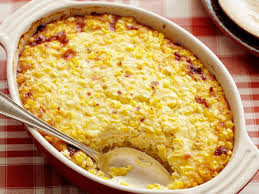 1874 nantucket corn pudding, a large, extremely corny casserole that did seem “very Yankee.” This was tasty, but our cook had a few complaints: the dish size called for was way too small, and the cooking time was wildly underestimated. Mildred justice’s golden puddding was a similar idea, featuring carrots, corn, and squash bound with eggs, milk, and cornmeal. Ground allspice was an inspired touch that lifted this dish from ordinary to differently delicious. Leftovers kept well. Blueberry and butternut squash salad with dried blueberry vinaigrette (this book seemed to have a lot of very long recipe names!) was your basic hearty, main-dish salad; but what really kicked it up a notch was the fantastic dressing, “delicious!” Kale salad with miso dressing and spiced pecans also had a “great!” dressing, “I didn’t expect to like it– but I did!” Mango, avocado, and dried cranberries added enjoyable flavors and textures. Since June is strawberry season in these parts, one cook made
1874 nantucket corn pudding, a large, extremely corny casserole that did seem “very Yankee.” This was tasty, but our cook had a few complaints: the dish size called for was way too small, and the cooking time was wildly underestimated. Mildred justice’s golden puddding was a similar idea, featuring carrots, corn, and squash bound with eggs, milk, and cornmeal. Ground allspice was an inspired touch that lifted this dish from ordinary to differently delicious. Leftovers kept well. Blueberry and butternut squash salad with dried blueberry vinaigrette (this book seemed to have a lot of very long recipe names!) was your basic hearty, main-dish salad; but what really kicked it up a notch was the fantastic dressing, “delicious!” Kale salad with miso dressing and spiced pecans also had a “great!” dressing, “I didn’t expect to like it– but I did!” Mango, avocado, and dried cranberries added enjoyable flavors and textures. Since June is strawberry season in these parts, one cook made  rosalie’s chilled strawberry soup, a very pleasant, cooling concoction of wine-marinated berries, sugar, and yogurt. We sampled this at our meeting and it was a winner! The red wine was the perfect accent, bringing all the flavors together without dominating. There was some discussion about what to do with the extra wine (the recipe only needs a cup or two). Hmm… not really a problem!
rosalie’s chilled strawberry soup, a very pleasant, cooling concoction of wine-marinated berries, sugar, and yogurt. We sampled this at our meeting and it was a winner! The red wine was the perfect accent, bringing all the flavors together without dominating. There was some discussion about what to do with the extra wine (the recipe only needs a cup or two). Hmm… not really a problem!
Despite the heat, a few people still felt the need to bake. Mermaid farm milk ricotta and lemon muffins looked unappealingly pale, but they were yummy and tender with just-right lemon flavor. Can’t judge a muffin by its cover? Old-time blueberry grunt was also a fairly homely looking dessert, and was a grunt of a different sort. Most of us had the impression that a grunt is very similar to a cobbler, but this version is more like British summer pudding, in which cooked fruit is mixed with chunks or slices of bread and then chilled. Though the texture of this dessert was a bit unusual, you can’t go wrong with blueberries and sugar. And 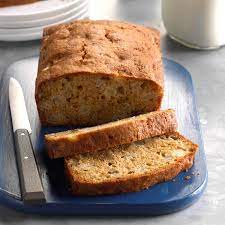 pear walnut bread was definitely a keeper, “I liked it so much I made it twice!” The chopped pears added subtle moistness and quiet flavor, and the classic combination of cinnamon and nutmeg was the perfect accent.
pear walnut bread was definitely a keeper, “I liked it so much I made it twice!” The chopped pears added subtle moistness and quiet flavor, and the classic combination of cinnamon and nutmeg was the perfect accent.
Despite a few keepers, for all of us, this book failed to impress. It seemed fairly dated, and many of the recipes (with some notable exceptions) seemed a bit too ordinary. And there were enough complaints about timing and directions that made us wonder if some of the recipes had even been tested. While the author’s stories and history are fun to peruse and make for good conversation, in a cookbook we also want stellar food, and for us this book mostly didn’t have it. And, the annoyances of the book’s organization and the atrocious index didn’t help matters. So, perhaps unsurprisingly, our rating averaged out to just a hair under 2 (out of a possible 5). Ouch! That might be our lowest score ever.
June marks the end of our Bibliobites “year.” We’ll take a break until September, when we’ll meet on the 29th at 11 AM in the Fireplace Room. Enjoy the summer, and see you in the fall!
*From a bit of doggerel attributed to Holy Cross alum John Collins Bossidy (1910):
“And this is good old Boston/The home of the bean and the cod,
Where the Lowells speak only to Cabots/And the Cabots speak only to God.”






